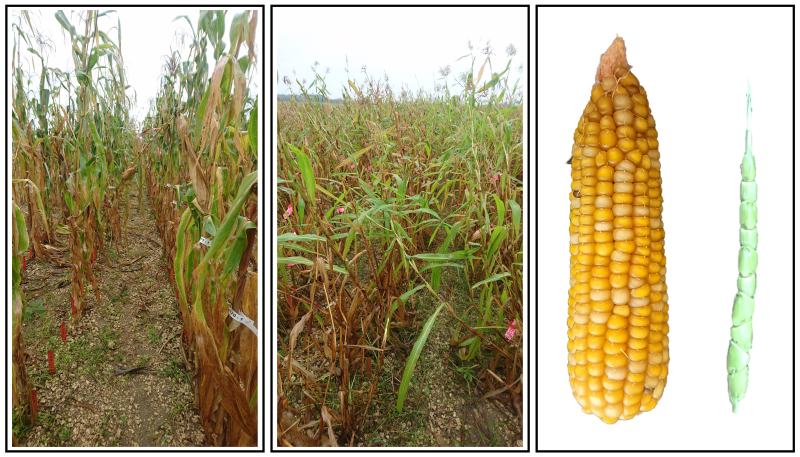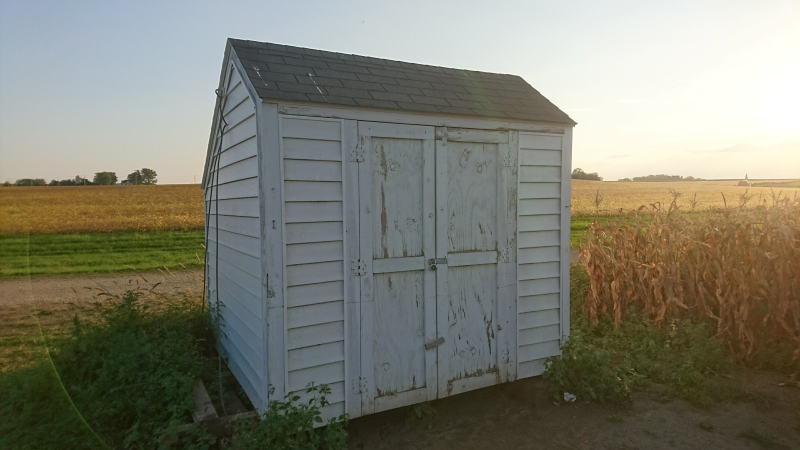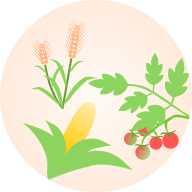Maize Domestication
Maize (Zea mays ssp. mays) was domesticated from teosinte (Zea mays ssp. parviglumis) in the Balsas river valley of Mexico approximately 9,000 years ago. This is supported by molecular (Matsuoka et al 2002) and archaeological (Piperno et al 2009) evidence. At a quick glance, maize and teosinte may appear to be very different. But, if you look carefully, you will find a number of similarities between the two.

Left: maize plants, middle: teosinte plants, right: maize vs teosinte ears (not to scale).
All of my work on maize domestication was done when I was a PhD student in John Doebley’s lab at the University of Wisconsin-Madison. It was a great working with so many awesome people. Doing a PhD is never easy but it was a great experience with lots of fond memories.
My first project was on fine-mapping a quantitative trait locus (QTL) responsible for ear internode length. This QTL was identified in Studer and Doebley (2011) as enhancer of teosinte branched1.2 (etb1.2) due to its interaction with the key domestication gene, teosinte branched1 (tb1). The etb1.2 QTL is located near tb1 on chromosome 1. The work began with recombinant screening in population segregating for maize and teosinte allele at etb1.2, which can be laborious and you better hope your QTL of interest is in a region with high recombination rate. Fortunately, this was done before I joined John’s lab and so I was able to dive right into phenotyping and fine-mapping work. Ear internode length describes how compact can the kernels be packed in a single ear, and it is measured by averaging the distance spanning 10 consecutive kernels. I recall that the measurement was not easy - most ears were not fully filled and sometimes it was impossible for find 10 consecutive kernels! We had to improvise - it was fairly easy to tell if there is only one missing kernel - but it gets harder with more missing kernels. As a good practice, we only measured the distance in the middle of the ears where the kernels are more uniform and avoided missing kernel near either ends of the measurement. It was fun to go through each ear, count and mark the kernels with a sharpie, and measured with a caliper. By relating the phenotype to the marker genotypes of the recombinant lines, we were able to narrow etb1.2 down to a fairly small upstream region of a gene known as ZmYAB2.1 which encodes for a YABBY transcription factor. Yay! And that was not the end, we followed up with some gene expression work and diversity sequencing to further characterize the mechanism and causative factors for the difference in ear internode length. The causative factors turned out to be rather complicated - gene expression was reduced with maize promoter over teosinte, but the presence of a large transposable element insert in the first intron appeared to abolish the gene expression completely. Wild! When comparing lines segregating for both ZmYAB2.1 and tb1, we found the evidence of interaction at the level of gene expression and phenotype. We also had in situ hybridization results showing the spatial expression of ZmYAB2.1 done by our amazing collaborators, Clint and Madelaine. I can’t summarize this project well enough so please feel free to check out this paper. It is a little long but it has lots of details and work!
At about the same time, I was working with Liyan and Lexi on a project to identify additional QTL for prolificacy trait in maize and teosinte. Prolificacy is a measure of number of ears on a single lateral branch, which is one in most maize and tens in teosinte. Previous work by Wills et al (2013) showed a large effect QTL on chromosome 1 and mapped it to a gene known as grassy tillers1 (gt1) but they also found that a third of maize lines carry teosinte alleles yet exhibit non-prolific phenotype. At that point, it was thought that perhaps a different causative gene is responsible for the non-prolific phenotype in these maize lines. So, we made three F2 segregating populations between these lines (NC358, Sg18 and T8) and W22 line with teosinte introgression in gt1 in an attempt to map the QTL for prolificacy. Surprisingly, the mapping results led us back to gt1. After some sequencing work, we found that these maize lines have a different haplotype in the regulatory region of gt1 that appeared similar to teosinte allele in the original gt1 marker. Furthermore, these maize lines turned out to be mildly prolific - they were not as prolific as teosinte but occassionally, you may find additional ears in a single lateral branch that may or may not develop to maturity. Anyway, the results were exciting and further add to the evidence of selection for multiple alleles during domestication. Please check out this paper!
During my time in John’s lab, most if not all of us were involved in developing the Teosinte Nested Association Mapping (TeoNAM) population. It was a highly laborious process of creating recombinant inbred lines for at least five populations (at least two populations dropped out due to poor quality). Each population was BC1S4, meaning the resulting F1 from maize W22 and teosinte inbred line was backcrossed to W22 once, and selfed for four generations. It was a great experience as it not only kept us busy in the summer, but also brought us plenty of undergraduate research training opportunities. For each undergraduate, he/she was responsible for at least one population, trait and season. This included work such as planting, weeding, phenotyping, harvesting and QTL mapping. TeoNAM is such a diverse and valuable resource, and I believe the seeds can be obtained through the Maize Genetics Stock Center. Please check out the TeoNAM paper.
Between 2014 and 2017, I spent four winter seasons in our field trials in Homestead, FL, which was thought to be my second home back then (jokingly, but not quite). We had a big joint project with Jim Holland’s lab at NCSU where we were growing up to 10,000 maize and teosinte plants each season. Because each plant was genetically unique, we had to do everything by hand including packing seeds, planting, labeling, collecting tissues, phenotyping and harvesting. Between the hard ground from mostly crushed up oolitic limestone and erratic weather in south FL, it was not easy to work with jab planters! If you happened to be in Miami, take a trip to Homestead and check out the fields. :) Anyway, this project was meant to compare various quantitative genetics parameters between maize and teosinte and relate the results to domestication. The project was actually split into two halves, each half having two seasons of field trials. For the first half in teosinte, we made random selfs and crosses between over 50 parents and we ended up with about half self-pollinated progeny and half cross-pollinated progeny. Similar process was done in maize landrace, but no cross was ever between maize and teosinte. Because maize landrace and teosinte are not inbred lines, their selfed progeny would still be genetically segregating. These crosses were important to us as they generate varying degrees of relationships between individuals, which allowed us to relate it back to the phenotypic variation for estimating heritabilities, variance-covariance and inbreeding depression coefficients. These populations served as proxies to ancient maize and teosinte in our little “time-travel” experiment in trying to better understand the change in trait genetic architecute during domestication. Several papers (Yang et al (2019), Chen et al (2020), Chen et al (2021), Samayoa et al (2021), Tittes et al (2023)) have come out from this project so please check them out!

Old shed that we used in West Madison Agricultural Research Station.
Publications
Yang CJ, Kursel LE, Studer AJ, Bartlett ME, Whipple CJ & Doebley JF (2016) A gene for genetic background in Zea mays: fine-mapping enhancer of teosinte branched1.2 to a YABBY class transcription factor. Genetics 204: 1573–1585. [Link]
Yang L, Yang CJ, Cheng Q, Xue W & Doebley JF (2016) Mapping prolificacy QTL in maize and teosinte. J Hered 107: 674-678. [Link]
Chen Q, Yang CJ, York AM, Xue W, Daskalska LL, DeValk CA, Krueger KW, Lawton SB, Spiegelberg BG, Schnell JM, Neumeyer MA, Perry JS, Peterson AC, Kim B, Bergstrom L, Yang L, Barber IC, Tian F and Doebley JF (2019) TeoNAM: a nested association mapping population for domestication and agronomic trait analysis in maize. Genetics 213: 1065-1078. [Link]
Yang CJ, Samayoa LF, Bradbury PJ, Olukolu BA, Xue W, York AM, Tuholski MR, Wang W, Daskalska LL, Neumeyer MA, Sanchez-Gonzalez JJ, Romay MC, Glaubitz JC, Sun Q, Buckler ES, Holland JB & Doebley JF (2019) The genetic architecture of teosinte catalyzed and constrained maize domestication. Proc Natl Acad Sci USA 116: 5643-5652. [Link]
Chen Q, Samayoa LF, Yang CJ, Bradbury PJ, Olukolu BA, Neumeyer MA, Romay MC, Sun Q, Lorant A, Buckler ES, Ross-Ibarra J, Holland JB & Doebley JF (2020) The genetic architecture of the maize progenitor, teosinte, and how it was altered during maize domestication. PLoS Genet 16: e1008791. [Link
Chen Q, Samayoa LF, Yang CJ, Olukolu BA, York AM, Sanchez-Gonzalez JJ, Xue W, Glaubitz JC, Bradbury PJ, Romay MC, Sun R, Buckler ES, Holland JB & Doebley JF (2021) A conserved genetic architecture among populations of the maize progenitor, teosinte, was radically altered by domestication. Proc Natl Acad Sci USA 118: e2112970118. [Link]
Samayoa LF, Olukolu BA, Yang CJ, Chen Q, Stetter MG, York AM, Sanchez-Gonzalez JJ, Glaubitz JC, Bradbury PJ, Romay MC, Sun Q, Yang J, Ross-Ibarra J, Buckler ES, Doebley JF & Holland JB (2021) Domestication reshaped the genetic basis of inbreeding depression in a maize landrace compared to its wild relative, teosinte. PLoS Genet 17: e1009797. [Link]
